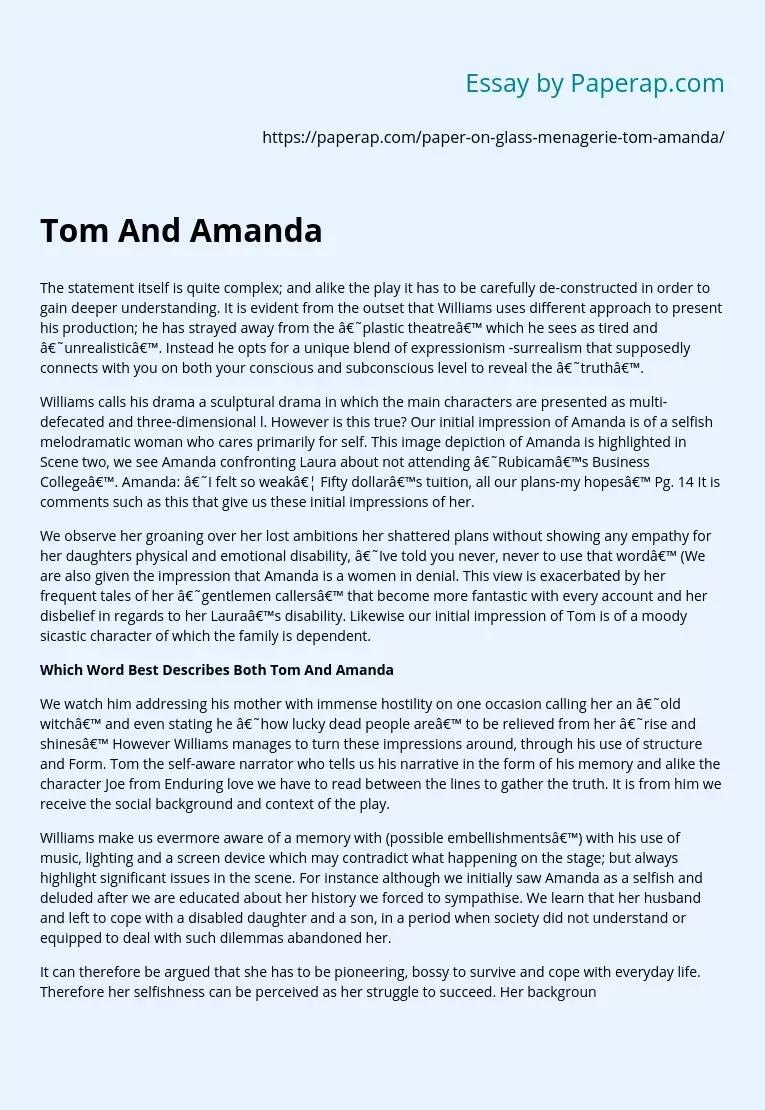Complex Statement Analysis
The statement itself is quite complex; and alike the play it has to be carefully de-constructed in order to gain deeper understanding. It is evident from the outset that Williams uses different approach to present his production; he has strayed away from the ‘plastic theatre’ which he sees as tired and ‘unrealistic’. Instead he opts for a unique blend of expressionism -surrealism that supposedly connects with you on both your conscious and subconscious level to reveal the ‘truth’.
Williams calls his drama a sculptural drama in which the main characters are presented as multi- defecated and three-dimensional l.
However is this true? Our initial impression of Amanda is of a selfish melodramatic woman who cares primarily for self. This image depiction of Amanda is highlighted in Scene two, we see Amanda confronting Laura about not attending ‘Rubicam’s Business College’. Amanda: ‘I felt so weak… Fifty dollar’s tuition, all our plans-my hopes’ Pg. 14 It is comments such as this that give us these initial impressions of her.
We observe her groaning over her lost ambitions her shattered plans without showing any empathy for her daughters physical and emotional disability, ‘Ive told you never, never to use that word’ (We are also given the impression that Amanda is a women in denial. This view is exacerbated by her frequent tales of her ‘gentlemen callers’ that become more fantastic with every account and her disbelief in regards to her Laura’s disability. Likewise our initial impression of Tom is of a moody sicastic character of which the family is dependent.
Which Word Best Describes Both Tom And Amanda
We watch him addressing his mother with immense hostility on one occasion calling her an ‘old witch’ and even stating he ‘how lucky dead people are’ to be relieved from her ‘rise and shines’ However Williams manages to turn these impressions around, through his use of structure and Form. Tom the self-aware narrator who tells us his narrative in the form of his memory and alike the character Joe from Enduring love we have to read between the lines to gather the truth. It is from him we receive the social background and context of the play.
Williams make us evermore aware of a memory with (possible embellishments’) with his use of music, lighting and a screen device which may contradict what happening on the stage; but always highlight significant issues in the scene. For instance although we initially saw Amanda as a selfish and deluded after we are educated about her history we forced to sympathise. We learn that her husband and left to cope with a disabled daughter and a son, in a period when society did not understand or equipped to deal with such dilemmas abandoned her.
It can therefore be argued that she has to be pioneering, bossy to survive and cope with everyday life. Therefore her selfishness can be perceived as her struggle to succeed. Her background can also be used to explain why she dwells in the past, as it can be argued that is a brief escape and relief from the hash reality of her life. Likewise the technical devices can be used to reveal the other dimensions of Toms character. For instance in scene six there is a screen image of a ‘sailing vessel with the Jolly Roger’. This highlights Tom’s dream of ‘adventure’ and ‘change’ and underlines his detest for the brain numbing warehouse.
When we look at it in this respect we can understand and emphasise with Tom, who is working in an institution he absolutely loathes -‘I’d rather someone… battered out my brains’ to support his family. Can we really criticise Tom for being so moody? Even our impression of Laura the (foundation of the play) changes. We initially see her as a shy, disabled young woman who cannot fend for herself. However as the play progresses and we watch how Tom and Amanda are strangled by of Laura needy state, and we start to see her as manipulative and uncompromising force.
To conclude Williams does manage to create multi-feacted characters through his innovative ‘sculptural drama’. We constantly hit with the sense of nostalgia are forced to connect with the characters on a conscious and subconscious level. It can be said that the method works so successfully because we consciously watch Tom’s memory meanwhile we equate what we are watching with society in on a subconscious level, which gives us a deeper understanding of not only the characters but also the whole play.
Complex Statement Analysis. (2019, Dec 05). Retrieved from https://paperap.com/paper-on-glass-menagerie-tom-amanda/

